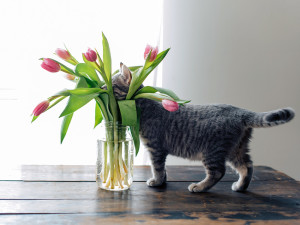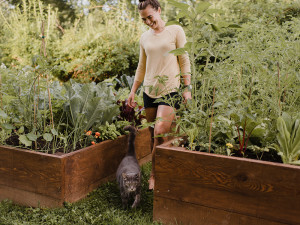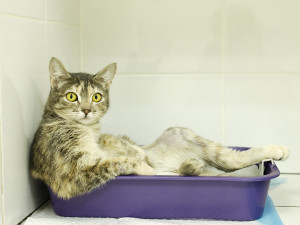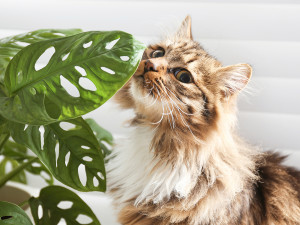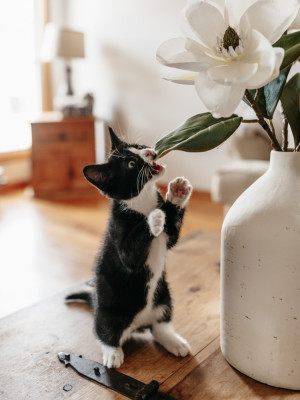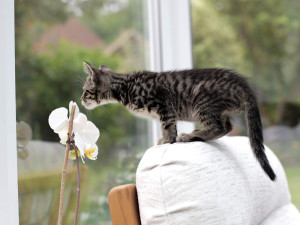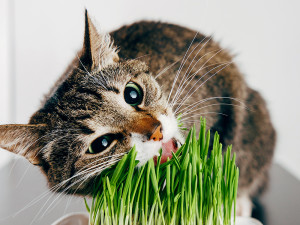Are Carnations Toxic to Cats?
If you receive this flower in a bouquet, keep it away from your cat.

Share Article
Carnations contain an unknown toxin that can be harmful to cats. Although symptoms of toxicosis are usually mild, they can include vomiting, diarrhea, and skin irritation.
Carnations (Dianthus caryophyllus) are commonly seen brightening up bouquets and decorative arrangements. It’s important to do a safety check before bringing any plant home with you if you have cats. Flower arrangements can be particularly challenging because they often consist of a variety of flower types, and it’s not always clear which species are included in the bunch.

littleKin™ is Kinship’s home just for puppy and kitten parents. Bop over to check out expert advice, new pet tools, and special deals—all curated for your newest family member.
opens in a new tabLearning to identify common toxic plants can help put your mind at ease and keep your cats safe from the unpleasant or dangerous effects of poisoning. If you’re ever unsure about what’s in a bouquet you’re bringing home, it’s always safer to ask a knowledgeable friend, florist, or use online resources to find out.
Why are carnations dangerous to cats?
Carnations contain an irritant that causes stomach upset in cats. Ingestion can result in vomiting and diarrhea. Although the symptoms of toxicity are usually mild, it’s best to keep these flowers out of your cat’s environment.
The same irritant can inflame the skin of cats that rub on the flower or get carnation pollen on their coats. The toxic principle in carnations has not been definitively identified at this time, but the symptoms of exposure to carnations are consistent enough that a toxin is suspected.
What should I do if my cat has eaten carnations?
The first step with exposure to any potential toxin is to remove the toxin from the environment. Move the carnations out of any area your cat can access. Be sure to pick up any fallen petals or leaves off of surfaces as well. Cats don’t know the plants are toxic, so they may go back for seconds if given the chance.
After you’ve prevented further exposure, try to determine how much of the plant your cat could have eaten. Look for chewed petals, missing leaves, or any other signs of disruption. Contact your veterinarian or an animal poison control center for further advice. Depending on how much your cat ingested, how your cat is acting, and if there are any pre-existing medical issues, they may recommend simple monitoring or veterinary intervention.
Diagnosing plant poisoning in cats
Cats aren’t the best at fessing up to their misdeeds, so much of the initial diagnostic work is up to their parents. Being cognizant of changes to plants in your house can help catch problems early. Many plant poisonings (including carnation toxicosis) cause stomach upset, so they can look similar.
Checking any piles of vomit in the house for plant material can also help to pinpoint plant ingestion as a cause of your cat’s illness. Plant material can’t always be identified after it’s been eaten, so it’s best to take preventative measures to make sure your cat doesn’t get exposed to a toxic plant.
More serious plant poisonings may require blood work to determine if they have affected your cat. Sometimes this blood work is monitored over a period of days to make sure that signs of delayed toxicity do not develop.
Symptoms of plant poisoning in cats
Carnation ingestion will most commonly cause vomiting or diarrhea. Cats will often improve once the irritating material has left their GI tract, but some can have prolonged signs and develop complications like dehydration or abdominal discomfort.
Treatment
Because most cases of carnation ingestion by cats involve a small amount of plant material, treatment is usually symptomatic. An anti-nausea medication may be given to stop vomiting and fluids may be administered to help replace what is lost with diarrhea. Most cats will feel better with these basic therapies, but some could require more intensive care if they ate a lot of carnations or if they are more sensitive to the toxic component.
How to prevent plant poisoning
Forethought is the key to preventing plant toxicity. Never assume that a plant is safe to have around your cat. Always double-check to make sure plants are non-toxic before bringing them home. Cats are often craftier than their parents give them credit for, so don’t think that a flower that’s placed out of reach will stay that way. A curious, determined cat can often get to places you’d think were inaccessible. It’s much safer to just not bring poisonous plants into a cat’s environment.
Are all parts of carnations poisonous to cats?
It’s hard to know exactly what parts of a carnation are unsafe because the toxic component isn’t known. It’s best to assume that all parts of the plant — including the flower, pollen, stem, and leaves — are unsafe for cats to eat or come into contact with.
How do I stop my cats from eating carnations?
Again, prevention is key. The best way to stop your cat from eating carnations is to not have them around in the first place. If you get a bouquet with carnations in it, remove them (and any other poisonous plants) before bringing it home. If you must have carnations in your house temporarily for whatever reason, keep them behind a closed door in a room your cat will not have access to.
The bottom line: Are carnations poisonous for my cat?
Carnations are poisonous to cats both if ingested and if contacted. They can cause vomiting, diarrhea, and local skin irritation. Choose other flowers to provide a pop of color in your home.
Other plants that are safe for cats
Roses (Rosa genus) are non-toxic to catsopens in a new tab and can be a great replacement for carnations. Just watch out for false roses like the Easter rose (Helleborus niger), moss rose (Portulaca oleracea), and rose of Sharon (Hypericum calycinum) that can cause poisoning in cats.
Orchids (Orchidaceae family) do not contain any toxinsopens in a new tab that affect cats, so feel free to beautify your home or garden with these varied, delicate plants.
Venus fly trapsopens in a new tab (Dionaea muscipula) aren’t dangerous to cats despite their aggressive reputations. These plants are carnivorous but feed on insects and spiders, so cats should be safe from their jaws.
Other plants that are dangerous for cats
Lilies (Lilium spp., Hemorocallis spp.) are another flower that is often found in arrangements. Lilies are one of the most dangerous plants opens in a new tabfor cats and ingestion of any part of the plant can cause acute renal failure.
Tulips (Tulipa genus) also have substances that can cause irritationopens in a new tab in a cat’s gastrointestinal tract. They can also contain tulip-specific chemicals that cause localized allergic reactions.
Azaleas (Rhododendron spp.) should be kept awayopens in a new tab from cats as well. They contain toxins that can cause vomiting, diarrhea, and heart failure.
FAQs (People also ask):
What happens if my cat eats a carnation?
Carnations can cause vomiting and diarrhea in cats if eaten. Symptoms are usually mild, but it’s safest to keep carnations away from cats to prevent problems.
Can cats eat carnation flowers?
Cats should not eat carnation flowers because they contain a toxin that irritates the gastrointestinal tract. This can result in vomiting, diarrhea, and abdominal discomfort.
Are carnations poisonous to cats if they smell them?
The toxicity from carnations is not transmitted by scent, but the irritant that causes problems for cats can be transferred by contact alone. Don’t let your cat close enough to carnations to allow them to smell or eat them.
References

Dr. Bartley Harrison, DVM
Dr. Bartley Harrison, DVM is a small animal veterinarian based in North Carolina who has practiced emergency medicine since graduating from the Texas A&M College of Veterinary Medicine. His primary interest areas include pain management, cardiology, and the treatment of shock.
He is a member of the Veterinary Emergency and Critical Care Society, American Veterinary Medical Association, and American Medical Writers Association. In addition to his clinical work, he writes pet health articles to help provide accurate information for both new and experienced pet parents. When he’s not working, he enjoys cooking, traveling, reading, and going on adventures with his dog.
Related articles
![Closeup portrait of calico cat sitting on home kitchen room table by pink rose flowers in vase, windows with blinds.]() opens in a new tab
opens in a new tabAre Roses Toxic to Cats?
They sure do like sniffing around those bouquets...
- opens in a new tab
Are Sunflowers Toxic to My Cat?
You’ve gotta love sunflower season—here’s why your cat can, too.
![A curious kitty playing with a vase of tulips.]() opens in a new tab
opens in a new tabAre Tulips Toxic to My Cat?
These flowers are cheerful, but you need to keep them far away from your kitty.
- opens in a new tab
How to Stop Your Cat From Munching On All of Your Precious Plants
Tips to get your cat to quit eating your greens.
![Half-bengal kitten indoors smelling white orchid flowers in a conservatory.]() opens in a new tab
opens in a new tabAre Orchids Toxic to Cats?
Find out whether you can get that elaborate flower arrangement—or if you should skip it.
![Cat playing in spider plant.]() opens in a new tab
opens in a new tabAre Spider Plants Toxic to Cats?
Learn what you should do if your “spider babies” and cat baby interact.
![Cat chewing on cat grass]() opens in a new tab
opens in a new tabThe 10 Best Non-Toxic House Plants for Cats
Cats love the crunch of a houseplant. These will do them no harm.
- opens in a new tab
Are Daisies Toxic to My Cat?
They’re cute in the garden, not so much for your cat. Here’s why.
